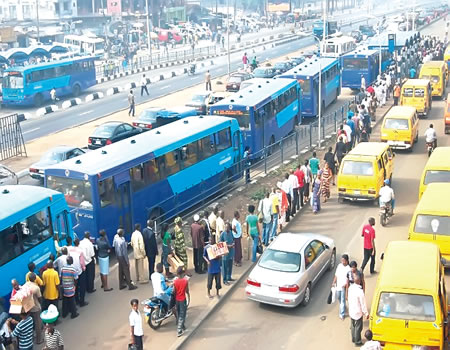MOST Lagos residents move from place to place by road. And due to the importance of this mode of transportation in the metropolis, vehicles of different types have been used, at different times. One of these is the notorious Molue, a long bus with capacity to carry over 100 passengers at once.
Characteristically, Molue is a metaphor of some sort – from sublime to ridicule. In those days, taking Molue as means of transportation was much cheaper, compared to its twin, Danfo and others such as taxi and Kabukabu.
But owing to the dangers inherent in Molue, former Governor Babatunde Fashola, in conjunction with the National Union of Road Transport Workers (NURTW), introduced the Lagos State Bus Asset Management Limited (LAGBUS) scheme as a way of sanitising the transport system in the state.
The initiative, when it was first launched, appeared to be the beginning of good times for regular travel from one place to another in the state. The type of orientation provided was impressive.
“In fact, before LAGBUS was introduced, one could never have assumed that road transportation system in Lagos could come with such convenience. The drivers were courteous, so also were the conductors. All the notoriety associated with old Molue was absent. The number of people standing was minimal, while hawking, begging and all sorts of activities were totally removed,” one of the commuters who spoke with Saturday Tribune on a LAGBUS vehicle which travelled from Ikorodu to Ketu said.
Back to the past?
However, nine months after, nothing has been done as LAGBUS buses have practically turned into the infamous Molue.
Noticeable negative changes in LAGBUS buses
The first noticeable change is that unlike before, conductors no longer sell tickets to passengers and the buses have to stop at every bus stop to call passengers like the Molue of old. Nearly all the buses are bad inside and outside. The interiors have deteriorated. It is also now a common sight to see the buses break down, thus subjecting commuters to untold hardship, as often found with Molue and common Danfo.
Mrs Bimbo Kolade, a market woman in Mile 12, told Saturday Tribune that the low fare is the only reason she still boards LAGBUS. “It is because of low fares that I still board their buses. From Mile 12 to Ikorodu, I spend N150 or N200, depending on the time of the day. It is cheaper than Danfo, which usually carry us, market women with loads, for between N300 and N400,” she said. Another respondent in Ketu, one Chidi, blamed the development on poor management. “You can blame the current government for the situation. Chasing them away from the BRT lanes contributed to the way they are now. They now struggle for passengers with privately owned public transport buses. The truth is, you can’t differentiate between the ones owned by touts and those being operated by the private firm,” he posited.
A former staff member of LAGBUS who craved anonymity said the management company should be blamed for current state of the buses. According to him, “I worked with them for more than a year and I can tell you that they lack proper management,” he alleged.
Taking a ride in LAGBUS buses is now reminiscent of the old Molue. The old habits have returned. Some of the buses have more than one conductor. Indeed, more than three persons stand at the front and back doors calling out to passengers or shouting at those already inside the vehicle.
The beauty and serenity that characterise LAGBUS’ introduction have since disappeared. Nearly all the existing ones tell a tale of neglect: no brake or rear lights; the seats are worn-out, while the fans installed for the comfort of passengers have stopped functioning. The chants of “no change” or “hold your change or I will join you together” have returned. Uneducated drivers with no regard for traffic rules and regulations have taken over the wheels of the buses. Most of the time, they drive recklessly on the roads.
“If the government can toe the line of Blue Bus operation by compelling LAGBUS operators to do the same thing, I think things will change for the better,” said Mr Abdulrasak Adigun, a resident of Ikorordu.
Commuters are also calling for proper monitoring and constant education.
LAGBUS troubled franchise
On November 7, 2016, Lagos witnessed a violent protest which nearly grounded the entire city. Thousands of commuters were stranded at various bus stops. More than 15 of them were seriously injured, while 12 public commercial buses were damaged. The state government had a hard time restoring peace. Although the crisis has since been resolved, issues that led to it are yet to be settled. Hapless commuters were made to bear the brunt of the problem.
Strangely, what was meant to be a solution provided to the menace, discomfort and road “madness” which commuters were always subjected to with the old public transport system known as Molue was the bone of contention, as operators in the transport system accused the government of sabotaging the solution it helped create.
While the government’s intention of providing good, quality and affordable transportation to residents has been commended, investigations showed that alleged shady contract dealings, conduct of government’s business under cloudy and clandestine circumstances as well as the godfather syndrome may have smeared such an intention.
When the Lagos State Bus Rapid Transit System, started operations in February 2007, it was with a lot of fanfare. LAGBUS, which was described as a “child of necessity,” created to manage the proposed new face of modern transportation in the state, officially began operations on February 17, 2007, but a little over a decade later, the celebrated project has become a shadow of its former self, as the operations of the buses under the scheme are now similar to the nearly extinct Molue, which the LAGBUS buses were meant to replace.
The introduction of the scheme was mainly to ease the movement of commuters, reduce the fares charged by commercial buses and bring some comfort and sophistication to the transport sector. At inception, it had over 500 buses which plied 40 routes. In line, with modern transportation, it had both prepaid and on-the-bus ticketing services and these were available in different denominations, practically on all the routes allocated to the programme.
To further enhance its operations, a window was also created for public participation with the management, in 2012, kicking off the LAGBUS franchise which became operational with 10 franchise companies, 17 operating routes and 238 buses.
To commuters, this seemed like the best thing to happen on Lagos roads. However, by November 7, 2016, the rot in the system had become so bad that the state governor, Mr Akinwunmi Ambode, banned LAGBUS buses from plying BRT corridors. This development, it will be recalled, sparked protests in parts of the state.
Even while the contract signed with LAGBUS by the franchisees was still running, another agency of the government, Lagos Metropolitan Area Transport Authority (LAMATA) went into another controversial franchise with another private firm, this time, Primero and exclusively ceded the lucrative BRT corridors in the state to it.
Commuters expressed anger following an allegation that godfatherism and cronyism were mainly responsible for the decision of the state government to dislodge the affordable LAGBUS and give Primero the opportunity to “exploit” commuters. A revelation that the main promoter of Primrose was a cousin to a major player in the emergence of Ambode’s administration, and, therefore, rumours that the coming of Primero was some sort of compensation incensed the residents.
Findings also suggest that commuters in the state have not forgiven Primero for the alleged “hijack” of the BRT corridors. A recent accident involving one its blue buses in which a hawker was killed was also seen as another opportunity to deal with the franchisee. A couple of the modern buses were set ablaze by a mob in the ensuing fiasco.
Before LAGBUS franchisees were controversially taken off the BRT corridors, the number had grown to 37. Although they were kicked off the lucrative lanes and their contract should still be running, none of them was ready to openly talk about what they are believed to see as “a grave injustice.”
About four of the franchisees contacted by Saturday Tribune refused to officially speak about their situation. They were also not ready to disclose the content of the disputed contract or say whether they were about striking another deal with the state government. They were not even ready to disclose their plans for the future or their investment in the project.
Not even LAMATA was ready to disclose the detail of the contract it signed with Primero when Saturday Tribune contacted the agency which now seems to see itself as an opponent to LAGBUS. LAMATA’s Head of Media and Communication, Mr Kolawole Ojelabi, simply said that the agreement with the current concessionaire of the BRT corridors, Primero Transport Services Limited was an exclusive right, adding that if those who had franchise with LAGBUS were disgruntled, they should channel their grievances to the appropriate quarters.
While a concession agreement could be exclusive, the question of whether it could also be without terminal date” is what is now agitating many minds, with some commuters saying that no agreement should be without a terminal date, because many things could go wrong in the course of executing the agreement.
The controversy over the status of LAGBUS today is also suspected to be the manner the franchise agreement with the operators was prepared, following the suspicion that the initial agreement handled by LAGBUS likely followed the LAMATA pattern with Primero, where clear lines were not drawn. This appeared to be a deliberate attempt to avoid disagreement, mischief and needless claims of entitlement in the future when the execution of such agreements might no longer be satisfactory to a party again.
While the LAMATA spokesperson was ready to confirm Primero’s numero uno status in the state’s transportation sector, his counterpart at LAGBUS, Mrs Oluyemi Adeoye, simply ruled out any possibility of our correspondent getting any sort of clarification on the controversial contracts. When reached on the telephone, she simply said she was not authorised to speak with the press on the vexed issues.
A certain Mr Alaka was also brought into the picture by LAGBUS sources. He is said to be the coordinator of the franchisees, liaising between them and the state government. A source who helped Saturday Tribune reach him returned with a negative response. The coordinator, who is suspected to also be a franchisee with greater influence in the government than many of his colleagues, also refused to speak on the controversy.
LAGBUS’ unusual protest
While LAGBUS franchisees are not ready to openly express their dissatisfaction with the withdrawal from the lucrative BRT routes, they are sending their message to the passengers instead of their partner, that is, the state government.
As of today, in the state, it is easy to tell the fortune of those running the duplicated schemes. While Primero blue buses plying the BRT corridors are doing well and looking every inch the prosperous one as noticeable in the appearance of their buses, the LAGBUS franchisees’ vehicles still in operation are nothing but a sore to the eyes. They look neglected and unkempt both inside and outside.
A source hinted that the current state of LAGBUS buses was due to their sack from the BRT corridors as those operating the franchise were not happy with the action of the state government and were, therefore, no longer encouraged to manage the buses well. The source said, “Since we no longer make profit as before, where do you expect us to get fund to manage the buses? A journey of 10 minutes has turned to one hour because we have to compete with other buses on the road but talks are ongoing with the government.”
Announcing the major shift last year, the state government, through the then Commissioner for Transportation, Mr Anofiu Elegushi, at a media briefing, announced the ban of LAGBUS buses from plying Ikorodu Bus Rapid Transit (BRT) corridor, stating that plans had been concluded to introduce Intelligent Traffic System along BRT corridor.
Elegushi added that the move was part of efforts of the current administration to boost commuters experience along the corridor, adding that though LAGBUS buses would no longer be allowed to utilise the BRT corridor to load or drop passengers, they could use the road like other private vehicles. The commissioner noted that the arrangement then had constrained the capacity of the BRT bus services to cater for the people, stating that the operations of LAGBUS buses had been moved to other 14 routes identified by the Lagos State Metropolitan Transport Master plan. He assured that the state government had concluded arrangement to allocate new routes to the operators of LAGBUS franchise.
But despite the state government not fulfilling its part of the withdrawal agreement of allocating new routes to the franchisees of LAGBUS, its agencies are still enforcing the agreement codes on the bus owners. Saturday Tribune was told by an insider that the task force unit of LAGBUS Asset Management are not idle as buses found to be unworthy of the road are always impounded and the owners made to pay a fine. The cost of compulsory repair of such vehicles by LAGBUS, the source said, must also be paid before the buses are returned to the owners. The fines are said to vary but no specific amount was disclosed.
An insider who did not want his name mentioned said the advert defacing the bus could be blamed on the franchisees as most of them rarely cared about what becomes of such adverts after running their stipulated contract period. “But as an agency, any advert that exceeds three months, we ensure it is either changed or taken off, with the consent of the owners of the advert because we pay to LASSA (Lagos State Signage Agency) for those adverts. The owners of these buses, most times, don’t cooperate and what we do is to impound such buses and the owners will pay the imposed penalty,” a source said.
We are for correction –Govt
A director in the state Ministry of Transportation who spoke with Saturday Tribune on the management of BRT said the government was not involved in the day-to-day activities of BRT. “Although as government we do regulate transport activities, operators like BRT and LAGBUS have managements, which are saddled with the responsibility of managing their activities. For example, while LAMATA is in direct control of BRT, NURTW is in charge of LAGBUS. But whenever we notice that their operations are not in line with the policy of government, or that members of the public are complaining of poor services, we are in a position to correct them,” the director said.







